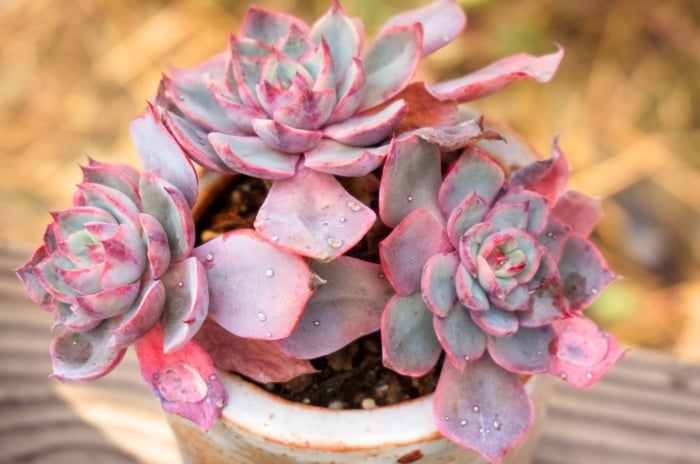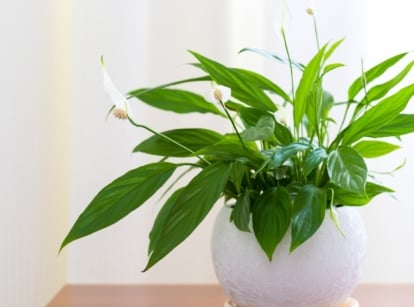Why Are My Prayer Plants Leaves Wilting and Drooping?
Prayer plants are beautiful and intriguing with their striking foliage and leaf-lifting habit. They're also a bit fussy about their care, and if they're not happy, they will let you know with those same lovely leaves. Gardening expert Melissa Strauss walks through some reasons why your prayer plant has droopy leaves.

Contents
The name prayer plant applies to several common houseplants, including Maranta, Calathea, Ctenanthe, and Stromanthe. They are distinct genera, but their leaves have some things in common.
Many have beautiful variegation in shades of green, white, pink, red, and sometimes chartreuse. Marantas have a trailing habit, while Ctenanthe and Stromanthe typically grow upright and clump forming. Calatheas can be either one or the other.
There is one characteristic they are most famous for, and the one they get their common name from. In the evening, they raise their leaves toward the sky, giving the appearance of praying hands. In the morning, they lower them once again.
As with many of the loveliest plants, they can be a bit fussy about their care and living conditions. With such beautiful and enchanted foliage, it’s natural to worry when you see your prayer plant wilting or drooping.
Let’s do a little troubleshooting and discuss why your prayer plant is looking sad.
The Short Answer
When it comes to prayer-plants with droopy or wilted leaves, the most common issue is water. These are sensitive to chemicals in tap water, and too much or too little can make that foliage flop as well.
Some less common causes of leaf issues in prayer plants include fluctuations in temperature and cold damage or low light, though this is rarely the culprit.
The Long Answer

Prayer plants are native to Central and South American jungle landscapes, where they live on the rainforest floor. They’re low-light plants and tend to be particular about their watering needs. Those particularities are the most likely cause of fallen foliage, but not always. Let’s talk about what might be at play that’s making your plant look sad and droopy.
Underwatering

These rainforest plants appreciate moisture. They thrive in consistently moist, well-drained soil. Depending on the size of the container, you can expect this plant to need weekly watering, possibly more during the growing season.
If your plant becomes dehydrated, it’s going to let you know by wilting. Initially, the foliage will begin to droop, and if you catch it in time, it should bounce back quickly. However, chronic dehydration will lead to brown tips and leaves turning yellow.
You might notice that along with hanging toward the ground, the leaves may begin to curl at the edges. Without proper watering, it’s likely to stop or slow its growth entirely. If you’re noticing any of these characteristics, check that soil. If the top inch is dry, it needs moisture. You’ll want to reduce watering in the winter, as they go semi-dormant, slowing growth and nutrient use.
Overwatering

It’s ironic that both of these things can cause similar effects, but overwatering is another common cause of wilted, unhealthy-looking leaves. This is more of a long-term issue, as it takes a while for water-logged soil to do its damage. However, in the grand scheme of things, it’s harder to come back from this one.
Wet soil is a breeding ground for fungi and other harmful pathogens. Decaying matter in the soil causes the roots to break down, and it will rot from the roots up. The sad thing about this is that once it gets to the foliage, it’s usually beyond saving.
The best way to avoid wet feet is to choose a pot or container with proper drainage holes. Many decorative indoor containers are hole-free to prevent damaging your furniture. If you have one that you love, it’s easy to work around this problem. Just put your prayer plant in a plastic nursery pot that fits down in the decorative one. When it’s time to water, lift it out, water it, and then allow it to drain completely before returning it to its home.
Chemicals in Water

We’re not done with moisture issues yet. There is one more significant one that can take a major toll on these tropical beauties. They are highly sensitive to chemicals that commonly show up in tap water. Specifically, fluoride and chlorine are enemies of those leaves.
So, how do you fix this one? There are a couple of ways, and they vary in the amount of effort they require. Some folks leave their tap water out overnight in the hopes that the chlorine will evaporate. I can’t speak to this method, but it does leave fluoride in the picture.
Rainwater is, of course, the gold standard. No one knows how to care for plants like Mother Nature. If collecting rain sounds like a bit too much work, grab a bottle of purified or distilled next time you’re at the grocery store. This works just as well.
Temperature

Prayer plants are warm-climate natives, and they don’t tolerate fluctuations or cold snaps. This is another culprit of soft and droopy leaves. It is possible to recover from a bit of this type of damage, but a frost will absolutely kill these.
Keep them away from doors and windows that open often in the winter. A consistent cold draft can be damaging. Don’t worry much about things heating up too much in the home. They tolerate temperatures in the range of 80-90°F (27-32°C) quite well.
Low Light

Low lighting is sometimes, but not often, the cause of floppy foliage. Since they are understory dwellers, prayer plants are happiest with moderate to bright indirect sunlight. If it’s bright enough, many of them will flower indoors. However, the flowers are not as noteworthy as the foliage, so it’s not something most plant owners worry about.
Because they don’t tolerate direct sun (it burns them), it can actually be easy to give them too little. If your watering habits are in line, and there haven’t been any major temperature changes, try moving it closer to a window.
Humidity

Like most other tropical rainforest dwellers, humidity is an important part of a prayer plant’s environment. Brown, drooping foliage and leaves that look brown and dry at the tips can be a result of chemicals. However, it can also be a lack of humidity. Keep things in the range of 40-50%, and this shouldn’t be an issue.
Natural Habit

Finally, it bears repeating that these plants have an interesting habit, where their leaves move up and down with the time of day. If you’re concerned because your prayer plant looks perky in the evening, and then by morning, the foliage falls downward, it’s ok. This is just what they do, and it’s part of their magic.
As long as everything else is in order and the leaves are not soft and curling, chalk up any variance to nature. This is a desirable trait and means that it is responding well to the amount of light it’s receiving.











